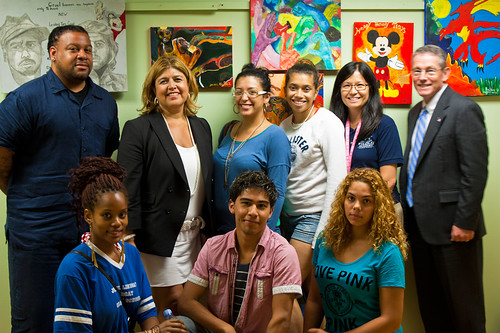Our children are our most prized possessions and we must do whatever it takes to help them excel in the future. Leading them on the path to becoming part of a healthier generation, USDA revised the standards for meals and snacks served in their schools. Recently, I had the pleasure of traveling to a New York City high school to see first-hand how students were adjusting to the new standards.
The changes to the meal and snack standards are in response to the passing of the Healthy Hunger-Free Kids Act of 2010. Implemented in the 2012 school year, the new meal standards made several changes. Now, the 32 million students participating in the National School Lunch Program can enjoy more fruits and vegetables, low-fat dairy products, whole grain foods and leaner proteins. The new smart snack standards, which will be implemented July 1, 2014, set minimum requirements for snacks sold in vending machines or as part of a la carte meals sold on campus during school hours.
I chose to visit John V. Lindsay Wildcat Academy because talking about the meal changes with the student body provides a unique perspective. I traveled to the school with my colleague, Food and Nutrition Service (FNS) Northeast Regional Branch Chief, Bob Foley. It was nice to hear how this school with students from all different ethnic and demographic backgrounds was receiving the new products. Their feedback offers insight about the program’s effectiveness in all of our nation’s communities.

I am glad to say that the children at Wildcat Academy were glad to have this open dialogue with USDA. They told us that they like the new foods and would love to see more! Part of our visit with the children also included some interesting discussions, including finding creative ways to increase the quality of foods served in the programs and reducing food waste. We even got a chance to provide the children some career counseling, discussing some of their options after graduation.
Events like this are great because they often tell us things that need to be addressed as we try to make a positive impact in our children’s lives. Wildcat Academy is a satellite campus, which presents a unique challenge since the majority of its students participate in the National School Lunch Program. Like many others, the school had to work hard to overcome this and other issues to make sure its students can receive at least one nutritious meal a day. The solution to this school’s distribution issue was to get its food delivered from a larger campus.
Wildcat Academy is one of 101,000 public, private, not-for-profit schools, and residential child care institutions across the country participating in the School Lunch and Breakfast Programs. My agency, the Agricultural Marketing Service (AMS), is dedicated to purchasing quality, nutritious foods for these students. The programs are administered by FNS, which helps set the standards and works with schools like Wildcat Academy to make sure everything is working properly at the local level.
As we get ready to head into a new school year, I look forward to more school visits. I can’t wait to see how other schools are adapting to the new meal and snack standards.


